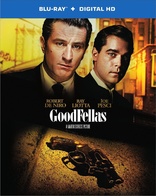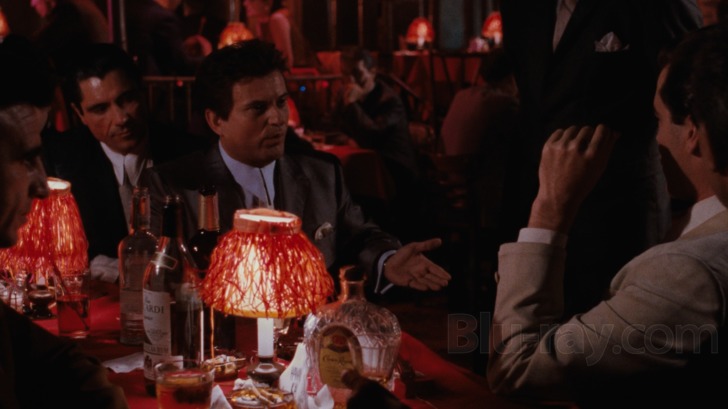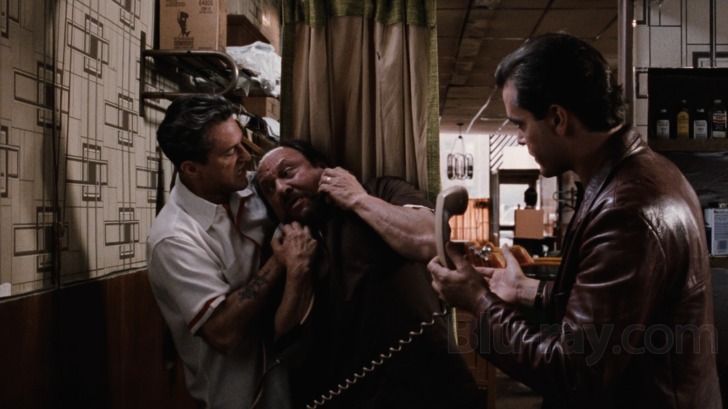GoodFellas Blu-ray Movie
HomeGoodFellas Blu-ray Movie 
25th Anniversary Edition / Blu-ray + UV Digital CopyWarner Bros. | 1990 | 145 min | Rated R | May 05, 2015

Movie rating
9 | / 10 |
Blu-ray rating
| Users | 4.8 | |
| Reviewer | 4.5 | |
| Overall | 4.5 |
Overview
GoodFellas (1990)
The life and times of Henry Hill, who grew up idolizing the wiseguys in his neighborhood and eventually became one of them. With his friends Jimmy Conway and Tommy De Vito, Henry lived the dream life of taking whatever he wanted and answering to no one—until everything caught up with him.
Starring: Robert De Niro, Ray Liotta, Joe Pesci, Lorraine Bracco, Paul SorvinoNarrator: Ray Liotta, Lorraine Bracco
Director: Martin Scorsese
| Crime | 100% |
| Drama | 90% |
| Epic | 63% |
| Biography | 29% |
Specifications
Video
Video codec: MPEG-4 AVC
Video resolution: 1080p
Aspect ratio: 1.78:1
Original aspect ratio: 1.85:1
Audio
English: DTS-HD Master Audio 5.1 (48kHz, 24-bit)
French: Dolby Digital 2.0
German: Dolby Digital 2.0
Italian: Dolby Digital 2.0
Spanish: Dolby Digital 2.0
Portuguese: Dolby Digital Mono
Czech: Dolby Digital 2.0
Hungarian: Dolby Digital 2.0
Polish: Dolby Digital 2.0
Russian: Dolby Digital 5.1
Thai: Dolby Digital 2.0
Turkish: Dolby Digital Mono
Japanese: Dolby Digital 2.0
Japanese is hidden
Subtitles
English SDH, French, German SDH, Italian SDH, Japanese, Portuguese, Spanish, Spanish SDH, Cantonese, Czech, Dutch, Greek, Hebrew, Hungarian, Korean, Mandarin (Simplified), Mandarin (Traditional), Polish, Romanian, Russian, Thai, Turkish
Discs
50GB Blu-ray Disc
Two-disc set (2 BDs)
UV digital copy
Playback
Region free
Review
Rating summary
| Movie | 5.0 | |
| Video | 4.5 | |
| Audio | 4.0 | |
| Extras | 4.0 | |
| Overall | 4.5 |
GoodFellas Blu-ray Movie Review
What's So Remastered About ME?
Reviewed by Michael Reuben April 27, 2015For as far back as I can remember, my father hated gangster movies—not the classics of Warner Brothers' golden years like Little Caesar and The Public Enemy, where the gangsters were evil reprobates who always got what was coming to them, but the modern gangster films that began with Arthur Penn's Bonnie and Clyde, where the criminals were portrayed as fully rounded, three-dimensional human beings, who often became heroes in the public imagination. My dad grew up in a poor Chicago neighborhood, and he'd seen his share of tough guy antics by the time he was a young adult. Like Henry Hill's father, both in Goodfellas and in real life, he wasn't impressed. I was twenty when The Godfather was released, and I found its operatic grandeur intoxicating. My father reviewed it in one sentence: "They sure glorified those hoodlums, didn't they?" I don't know whether my dad ever saw director Martin Scorsese's Goodfellas, but if so, I doubt he lasted to the end. At the literal level, Scorsese's dramatization of small-time gangster Henry Hill's biography demonstrates how thoroughly the life of organized crime corrupts and consumes everyone in it, along with their families, friends and anyone unfortunate enough to cross their path. But the paradox of Goodfellas, and one of the essential qualities that makes the film an enduring classic, is how effectively Scorsese conveys the allure of that life, the attraction of easy money, freedom from responsibility and swaggering indulgence. Henry Hill's friends all die or go to jail, and he ends up an average "schnook" living in Witness Protection and pining for the glory days, but until then it's a helluva ride—and Scorsese makes it so exhilarating that it's just as easy for the audience to overlook the consequences as it was for the real Henry Hill. Goodfellas is both a warning and an invitation. It's a cautionary tale that tempts viewers to throw caution to the wind, because the train to hell has the best party in town.

Goodfellas retells, and somewhat fictionalizes, the life of Henry Hill (Ray Liotta), the son of an Italian mother and an Irish father, who grew up in the East New York section of Brooklyn in the 1940s idolizing local members of the Lucchese crime family. The screenplay by Scorsese and Nicholas Pileggi, based on Pileggi's book Wiseguy, is shaped as a memoir, with Henry narrating the story in voiceover and, near the end, addressing the audience directly on camera. His tone ranges from matter-of-fact to wistful, even nostalgic, as he relates his history of violence and crime. (Ray Liotta listened to hours of Pileggi's interviews with the real Henry Hill, and he has said that he was struck by how casually Hill munched on potato chips even when discussing brutal murders.) The film's structure as a memoir works with Scorsese's stylistic goal, which is to convey the feel of Henry Hill's life as a gangster, or, as Scorsese puts it in the letter accompanying this new Blu-ray release, of a life that might "spin out of control at any moment". Despite its meticulous attention to detail in costume and production design, Goodfellas is anything but naturalistic. Its narrative flows in the expressive fashion of memory, sometimes jumping back, occasionally lingering on a moment, usually racing forward. The film is full of freeze-frames, odd shifts in perspective, abrupt camera moves, even an occasional switch in the narrator after Henry's future wife, Karen (Lorraine Bracco), enters the story. Sometimes the camera mimics Henry's point of view, but other times it goes places where Henry never was but must have imagined. At pivotal moments, the narrative is interrupted by brief flashes of Henry's friend, Tommy DeVito (Joe Pesci, in an Oscar-winning performance), and he's always firing a gun, because it's Tommy who serves as the story's gangster "id": an unadulterated brute force that answers to no one, not even the "made" men and bosses who constitute the underworld's social hierarchy. Boss Paulie Cicero (Paul Sorvino) calls Tommy "a bad seed", and Tommy's inability to exercise even the smallest restraint on his violent impulses ultimately destroys him. Unlike The Godfather, which was set among mob aristocracy, Goodfellas focuses on the Joe Sixpacks of crime, "blue collar guys", as Karen Hill calls them. Henry is an outsider from the moment we meet him as a kid (played by Christopher Serrone) pressing his face against the bedroom window, entranced by the preening hoodlums greeting each other at the cab stand across the street. He remains an outsider, even when he's adopted as a go-for by the cab stand crowd and given an apprenticeship in crime under the Irish thief, Jimmy Conway (Robert De Niro), which is where he and Tommy meet and become friends. It's no accident that Henry is sent to Jimmy; the youngster has already been "tracked", because neither of these two Irish outsiders can ever be part of the inner circle of an Italian crime family, even though Jimmy is respected as "a good earner". Henry doesn't yet see the limits on his life, because daily existence is so exciting. "We were treated like movie stars", he says, and the only requirement is the willingness to live outside the law and stick together. The rewards are immense: money, booze, women, drugs and "respect" (born of fear). Even after Henry weds Karen, the party continues. But the celebration comes to an abrupt halt when one of Henry's jobs for Jimmy draws him an arrest and a prison sentence, which is as much an occupational hazard for wiseguys as getting "whacked" by one of their own. Now that he is no longer contributing to the bottom line, Henry suffers the fate of many a blue collar worker in the legitimate world—he's disposable. With Paulie and the organization doing nothing to help Henry's wife and children, Henry organizes a profitable drug trade from his jail cell. After his release, he sees no reason to abandon it, even though the boss, Paulie, orders him to do so. Drug trafficking, and Henry's personal indulgence in his own product, become his downfall. In Goodfellas' final act, Scorsese draws a memorable portrait of Henry as a man now hooked on cocaine as both a means of subsistence and a personal fuel. With Liotta's voiceover narration breathlessly speeding along and the musical soundtrack leaping from one selection to another, like someone impatiently punching buttons on a playlist, Scorsese follows an increasingly paranoid Henry as he drives around town, scanning the skies for a surveillance helicopter he's sure is following him. His drug addiction mirrors his addiction to the gangster life. It has made him feel more vital and alive, but it has also isolated him, disconnecting him from the rest of the world, invading every aspect of his life, requiring him to take increasingly greater risks, and sacrifice even more of himself and those close to him, to maintain the high. This road only has two destinations, death or prison (or Witness Protection, which, as Henry describes it at the film's end, feels like a living death). The unnerving achievement of Goodfellas is how thoroughly it demonstrates the no-win consequences of the gangster life and yet still makes that life seem so tempting. No wonder David Chase, whose hit show The Sopranos descends directly from Goodfellas, has called it his "Koran".
GoodFellas Blu-ray Movie, Video Quality 

Goodfellas was photographed by cinematographer Michael Ballhaus, who has shot several films for Scorsese, including The Departed. Warner first released the film on Blu-ray in 2007 and has since re-released the same disc several times, including a 2010 DigiBook with a feature-length documentary on gangster films on a separate DVD. Fans of Goodfellas have long been hoping for a remaster, and for the film's 25th anniversary, it has finally arrived. Under Scorsese's supervision, Goodfellas has been newly scanned at 4K resolution from the original camera negative ("OCN"), then color-corrected in the digital domain. Having never watched the 2007 Blu-ray release (although I've seen the film many times), I came to this version fresh, and the presentation is spectacular. Clarity, sharpness and densities are superb. The blacks are deep, and the contrast is excellent. Colors are wonderfully saturated, without any bleeding, which is especially important due to the frequent and strategic use of bright red lighting. Key scenes at night, such as the opening sequence with Henry, Tommy and Jimmy driving in a car, then stopping to check the trunk because they hear a noise, look terrific, because the faces and figures are illuminated just enough to stand out from the darkness around them. Large crowd scenes like the wedding of Henry and Karen or their first date at the Copacabana remain detailed even in long shots. As Scorsese says in the letter accompanying this release, he tried to pack every frame "with motion and detail", and this Blu-ray rendition allows all of it to be seen. A natural-looking grain pattern is readily observable that, in motion, is much finer than may appear when frames are frozen for screenshots. It no doubt helps that Warner has placed all the extras on a second disc and devoted most of a BD-50 to the feature, yielding an average bitrate of 27.33 Mbps, which is a significant improvement over Warner's frequently low rates. After I watched the new version of Goodfellas, I popped in a copy of the 2007 release, and the difference was immediately obvious. By comparison, the 2007 release looks like it is covered with a layer of haze, largely because the contrast is too high and the image is overbrightened. This may have resulted from an attempt to increase the perception of detail on an older scan, but the new transfer needs no such aid. The detail is there for real, and the greater accuracy in black level and contrast provides more sense of transparency and depth. The screen capture equipment we use at Blu-ray.com does not allow for easy selection of a specific frame, but I have tried to come as close as possible to the twenty screenshots included with Ken Brown's review. Readers will no doubt observe a significant shift in colors between the 2007 release and the new version. In motion, I found the difference less dramatic than it may appear from side-by-side comparisons of individual frames. In any case, there is no reason to believe that the colors of the 2007 release were accurate. Before the era of digital intermediates, media for theatrical release and home video were often prepared from different sources (and, for a new medium like Blu-ray, at different times), so that no guarantee of consistency existed. This is why it is so valuable to have the filmmakers involved in the process of creating a Blu-ray, because they can at least remember their artistic goals and choices, even if they may have forgotten the specific shade of blue of a suit jacket in a particular scene. Given Scorsese's prominence as an advocate and financial supporter of film preservation, one can reasonably expect that his supervision of this transfer of Goodfellas also involved consulting whatever sources were available for checking the accuracy of the film's colors. Such a detail-oriented filmmaker would be unlikely to overlook so obvious a point.
GoodFellas Blu-ray Movie, Audio Quality 

Goodfellas was released to theaters in Dolby Surround, then remixed in Dolby Digital 5.1 for its DVD release. The same Dolby Digital mix was included on the 2007 Blu-ray release, but the new disc has a lossless DTS-HD MA 5.1 track that brings the film's unique sound mix fully to life. The sonic style of Goodfellas, overseen by Skip Lievsay (a recent Oscar winner for Gravity), is a kind of organized cacophony of dialogue, narration, specific sound effects that are deliberately too loud so that they break through and grab the viewer's attention, other effects that linger in the background creating unease, abrupt eruptions and sudden silences. Through it all winds the lengthy playlist of songs, carefully chosen from the periods covered by the film, which cut in precisely to comment, often ironically, on the action. The film has no original score; its music is entirely that of its era, but it is reproduced here with beautiful clarity, distinct stereo separation (if the original recordings permit) and an open sense of space thanks to the multi-channel format. Solid bass extension adds impact to key moments of violence, and some of the gunshots reverberate through the sound array. The dialogue remains clear even when it overlaps (no small achievement in the scenes of wiseguys joking, drinking and laughing uproariously). In the famous scene where Tommy shoots Spider (Michael Imperioli) in the foot, you can actually hear the phrase that leads Spider to mistakenly believe Tommy doesn't want a drink.
GoodFellas Blu-ray Movie, Special Features and Extras 

The second disc of this two-disc Blu-ray set contains all the extras from the 2010 DigiBook release, except for the commentaries, which accompany the film. Please refer to Ken Brown's review for a listing and description. New to this release are a current documentary, a book and a letter from Martin Scorsese.
- Scorsese's Goodfellas (1080p; 1.78:1; 29:54): Produced by Brett Ratner, this new retrospective documentary isn't quite what is described on the Blu-ray's back cover, which lists several interviewees who don't appear (namely, Jack Nicholson and Joe Pesci). But it's still a fine documentary filled with memorable stories and observations from a wide array of commentators. Participants from the Goodfellas clan include Scorsese, Pileggi, Liotta, De Niro, Bracco, editor Thelma Schoonmaker and producer Irwin Winkler. Additional participants include Harvey Keitel, Leonardo DiCaprio and Terence Winter, creator of Boardwalk Empire and screenwriter of The Wolf of Wall Street.
- Book: The 36-page book contains a fine collection of film and production stills and an insightful essay entitled "The American Dream Gone Mad: The Legacy of Goodfellas".
- Letter: Scorsese's letter summarizes his artistic goals for the film and acknowledges his collaborators.
GoodFellas Blu-ray Movie, Overall Score and Recommendation 

One of the points made repeatedly in the new documentary accompanying this release is how familiar the world of Goodfellas was to Scorsese, because, like the young Henry Hill in the film, he had observed it from his bedroom window. Ray Liotta recalls the director personally tying the actor's tie to look just so, which is one of a thousand details that add up to the engrossing world into which the film immerses the viewer. The director's intuitive grasp of that world was essential to Goodfellas' remarkable balance between celebration and warning, a balance so delicately poised that it's entirely up to the viewer which way it tips. Highest recommendation.
Other editions
GoodFellas: Other Editions

GoodFellas 4K
1990

GoodFellas 4K
1990

GoodFellas
1990

GoodFellas
20th Anniversary Edition
1990

GoodFellas
25th Anniversary Edition | Movie-Only Version
1990

GoodFellas
1990

GoodFellas
1990

GoodFellas
1990

GoodFellas
25th Anniversary Edition | with Instawatch
1990

GoodFellas
1990

GoodFellas
1990

GoodFellas
Anniversary Edition | Iconic Moments
1990

GoodFellas
Academy Awards O-Sleeve
1990

GoodFellas
1990

GoodFellas
Anniversary Edition | Iconic Moments
1990

GoodFellas
FYE Exclusive Steelbook
1990
Similar titles
Similar titles you might also like

The Godfather: Part II 4K
1974

The Wolf of Wall Street 4K
2013

The Godfather 4K
1972

Once Upon a Time in America
Extended Director's Cut
1984

Casino 4K
1995

Live by Night
2016

The Godfather: Part III
1990

Carlito's Way 4K
1993

American Gangster 4K
2007

King of New York
1990

The Irishman
2019

Capone
2020

Boardwalk Empire: The Complete First Season
2010

Scarface 4K
Gold Edition
1983

There Will Be Blood
2007

Black Mass
2015

Blow
2001

Wall Street
1987

Drive
2011

The Sopranos: The Complete Series
1999-2007